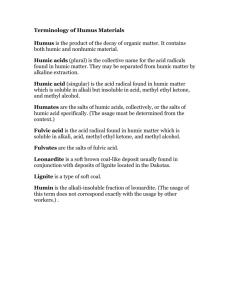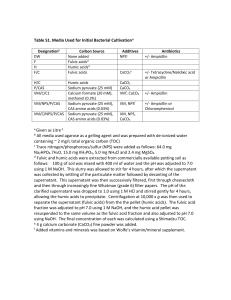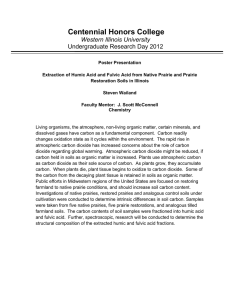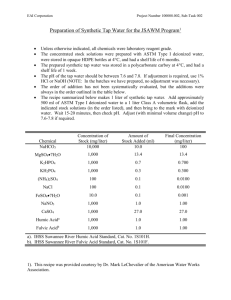Ful-Power: Fulvic Acid for Plant Growth & Health
advertisement
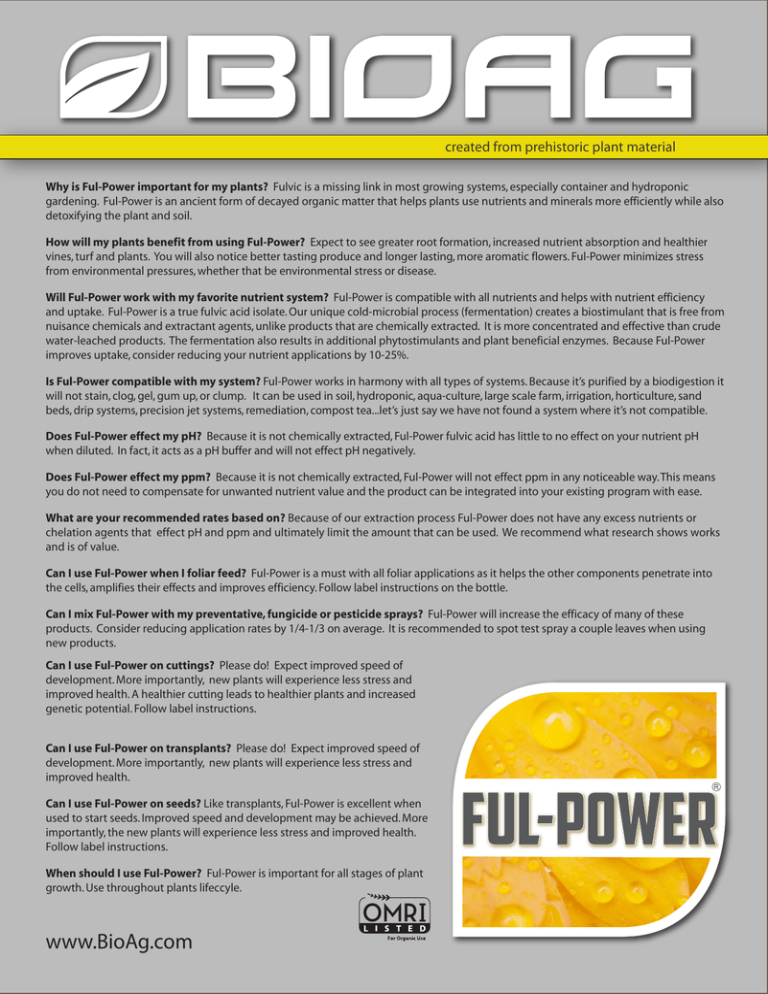
created from prehistoric plant material Why is Ful-Power important for my plants? Fulvic is a missing link in most growing systems, especially container and hydroponic gardening. Ful-Power is an ancient form of decayed organic matter that helps plants use nutrients and minerals more efficiently while also detoxifying the plant and soil. How will my plants benefit from using Ful-Power? Expect to see greater root formation, increased nutrient absorption and healthier vines, turf and plants. You will also notice better tasting produce and longer lasting, more aromatic flowers. Ful-Power minimizes stress from environmental pressures, whether that be environmental stress or disease. Will Ful-Power work with my favorite nutrient system? Ful-Power is compatible with all nutrients and helps with nutrient efficiency and uptake. Ful-Power is a true fulvic acid isolate. Our unique cold-microbial process (fermentation) creates a biostimulant that is free from nuisance chemicals and extractant agents, unlike products that are chemically extracted. It is more concentrated and effective than crude water-leached products. The fermentation also results in additional phytostimulants and plant beneficial enzymes. Because Ful-Power improves uptake, consider reducing your nutrient applications by 10-25%. Is Ful-Power compatible with my system? Ful-Power works in harmony with all types of systems. Because it’s purified by a biodigestion it will not stain, clog, gel, gum up, or clump. It can be used in soil, hydroponic, aqua-culture, large scale farm, irrigation, horticulture, sand beds, drip systems, precision jet systems, remediation, compost tea...let’s just say we have not found a system where it’s not compatible. Does Ful-Power effect my pH? Because it is not chemically extracted, Ful-Power fulvic acid has little to no effect on your nutrient pH when diluted. In fact, it acts as a pH buffer and will not effect pH negatively. Does Ful-Power effect my ppm? Because it is not chemically extracted, Ful-Power will not effect ppm in any noticeable way. This means you do not need to compensate for unwanted nutrient value and the product can be integrated into your existing program with ease. What are your recommended rates based on? Because of our extraction process Ful-Power does not have any excess nutrients or chelation agents that effect pH and ppm and ultimately limit the amount that can be used. We recommend what research shows works and is of value. Can I use Ful-Power when I foliar feed? Ful-Power is a must with all foliar applications as it helps the other components penetrate into the cells, amplifies their effects and improves efficiency. Follow label instructions on the bottle. Can I mix Ful-Power with my preventative, fungicide or pesticide sprays? Ful-Power will increase the efficacy of many of these products. Consider reducing application rates by 1/4-1/3 on average. It is recommended to spot test spray a couple leaves when using new products. Can I use Ful-Power on cuttings? Please do! Expect improved speed of development. More importantly, new plants will experience less stress and improved health. A healthier cutting leads to healthier plants and increased genetic potential. Follow label instructions. Can I use Ful-Power on transplants? Please do! Expect improved speed of development. More importantly, new plants will experience less stress and improved health. Can I use Ful-Power on seeds? Like transplants, Ful-Power is excellent when used to start seeds. Improved speed and development may be achieved. More importantly, the new plants will experience less stress and improved health. Follow label instructions. When should I use Ful-Power? Ful-Power is important for all stages of plant growth. Use throughout plants lifeccyle. www.BioAg.com FUL-POWER not all FULVIC products are equal METHOD MATTERS: Humic substances are organic matter born from earth’s slow decay. Our sources are estimated to be 45 million years old. In making Ful-Power we mimic the earth’s natural digestive processes and take months to unlock these dynamic molecules, retaining their full potential and parent structure. Humic substances are not one molecule, repeated over and over. They are a set of molecules, under a given range, with similar characteristics. Think of snowflakes, alike in many ways, but also each unique. The more the structure is changed through chemical processes, heat and handling the further away we get from the full benefits. What sets our manufacturing processing apart? Ful-Power is made through a biodigestion, or fermentation, where microbes convert insoluble humic substances into the soluble, low-molecular-weight (LMW) fraction, or the fulvic fraction. The fulvic fraction is small enough to penetrate the leaf, cell and even the mitochondria within a cell and so we call it the bio-available fraction. The high-molecular-weight (HMW) fraction, or humic fraction, is left behind. It is too large to be absorbed by plants and instead is predominantly beneficial as a soil conditioner. The fermentation leaves enzymes (plus coenzymes), antioxidants and other delicate substances (which can be easily denatured) intact and the side chains open. Carbonyl groups (part of ketones and aldehydes), carboxylic groups, phenols, and complex carbohydrate are also protected. These components can undergo rearrangement, like intermolecular condensation reactions, in the presence of OH- (bases) and strong H30+ (acids). This can cause polymerization (clumping) of the molecules and reduce the number of open receptor cites that give fulvic acid much of its’ COMPLEXING and free radical scavenging abilities. When these materials are damaged and/or rearranged due to inferior processing it decreases the bio-availability of the product. Essentially, our process gently unwinds the material from the raw source in much the same way it was formed, thus creating a superior product. SO DOES GEOLOGY... Often humic substances are referred to as “Leonardite”. Technically, leonardite only comes from the Dakotas where it was discovered by Dr. Leonard. While Leonardite is a humic substance, it’s a relatively old humic substance (in comparison to younger formations that are still considered ancient) that was formed in the presence of salt water and has been highly weatherized. The result is a product that is high in the humic fraction, good for soil conditioning, but low in fulvic i.e. the biologically stimulating fraction. Most of the deposits around the world were formed from salt water deposits where grasses (sedge and reeds etc.) grew during the older carboniferous period and/or have been left exposed. The older material is more closely related to coal and oxidized slack lignite. There are few known deposits that are formed in fresh water AND that have not been oxidized or weathered. We have tested, and continue to test, sources from all over the world. Our sources are superior because they are agricultural grade: formed from fresh water deposits where large leafed plants (cycads, euphorbia etc.), high in latex and other beneficial substances, grew during the cretaceous period. We also seek out areas that are protected, and that have not been exposed to cracking and uplift. WHEN IT COMES TO HUMIC PRODUCTS, TEST! IT’S NOT ALWAYS WHAT IT SEEMS! Color can be a source of confusion. By definition fulvic is golden in color and humic is brown to black. If you ever purchase a dark brown “fulvic” product you can bet it’s got humic (or something else at least) in it and it’s hard to tell how much fulvic there really is. Even with a golden product there are ways of making it appear more concentrated, and there are a few tricks which can sway a guarantee analysis in ones favor. Add to this that labeling laws in some states require fulvic products to be labeled as humic products and it becomes very difficult to know what you are actually buying. The moral here is to buy from trusted sources and test. Ful-Power is a pure fulvic digested in Oregon coast rainwater. It does not contain extractants, additives or filler. It can vary slightly in color dependent on many factors, but it is typically gold to light orange. It is labeled as humic because of requirements in California and Oregon, and the guarantee is by the CDFA method (which throws out the fulvic and only measures the humic). KNOWLEDGE AND EXPERIENCE AT YOUR FINGERTIPS: Founder Dr. Robert Faust, Agronomist and Bioag Specialist, has been studying humates for over 40 years. Ryan Zadow, Biochemist and R&D manager, has been researching them for over 10. Collectively we’ve tested much of the raw humic substances from across the globe and scoured thousands of research papers. Amazingly, there are still new aspects of humic substances discovered regularly. We continue to keep tabs on the latest research as well as performing our own research here at BioAg. Grow Smart. Grow Strong.
